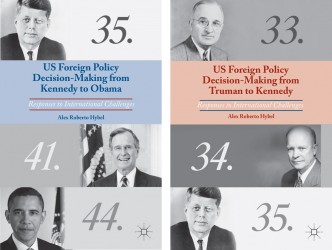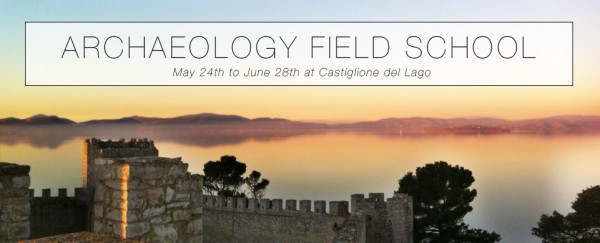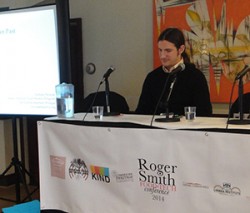 The Umbra Institute was one of the main sponsors of the Roger Smith Food Tech Conference in New York this past weekend. The food conference, which gathered scholars from across the world to discuss the effect of technology on food culture, was the fourth edition of the series. The Umbra Institute, whose innovative curricular concentration in Food Studies is now in its third year, also sent its associate director for the Food Studies Program, Zachary Nowak. Nowak, currently pursuing a doctorate in American Studies at Harvard University, gave two presentations. The first posed questions about the French notion of terroir, “the taste of place,” while the second was a historical investigation of pasta in Umbria.
The Umbra Institute was one of the main sponsors of the Roger Smith Food Tech Conference in New York this past weekend. The food conference, which gathered scholars from across the world to discuss the effect of technology on food culture, was the fourth edition of the series. The Umbra Institute, whose innovative curricular concentration in Food Studies is now in its third year, also sent its associate director for the Food Studies Program, Zachary Nowak. Nowak, currently pursuing a doctorate in American Studies at Harvard University, gave two presentations. The first posed questions about the French notion of terroir, “the taste of place,” while the second was a historical investigation of pasta in Umbria.
Category: Umbra Blog
This blog documents the experiences of students currently studying at the Umbra Institute in Perugia, Italy, offering an account of their day-to-day experiences, extra- and co-curricular activities, and special events. We hope you gain some insight into what adventures Umbra students find outside the classroom during their semester in Perugia, a medieval town in the mountains of Umbria. Cheers!
As Umbra’s spring semester is winding down, we asked several students to reflect on their study abroad experiences in Perugia. Ashley Patino, an alumna of Virginia Commonwealth University and a participant in Umbra’s Food Studies Program shared the following with us. This is the first in a special, three-part mini blog series.
———
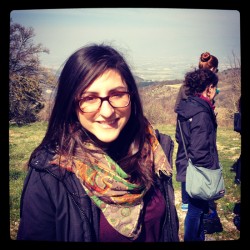 After hitting a point of transition at home (and having experienced Perugia once before), I sought out another reason to return. I found the Food Studies Program. It was almost insulting to not have heard of it sooner; everything it includes seems too good to be true. For those interested, or even mildly curious about gastronomy, the Food Studies Program offers a way to go beyond yourself.
After hitting a point of transition at home (and having experienced Perugia once before), I sought out another reason to return. I found the Food Studies Program. It was almost insulting to not have heard of it sooner; everything it includes seems too good to be true. For those interested, or even mildly curious about gastronomy, the Food Studies Program offers a way to go beyond yourself.
Through food, thousands of miles away from home, one can dive further to another time and space. Dario Cecchini’s lardo, for example, smeared on crostini and tasting so rich and prizing against the backdrop of another day of serenity in Tuscany… Prof. Elisa Ascione sheds enlightenment on the evolution of lardo, how it has come from a working-man’s calorie pack to a snack of protected origin and artisanry.
Aside from the field trips and feasts, the best part is having exciting professors who each have their own personality and expertise. They make the program; presenting students with a parabolic perspective of food, approaching food from dieting habits and agriculture through time to today’s instability and business markets. All of this is within an environment that encourages learning not just from the professors, but also from each other. There is something really special about being in a group that is conscious of the stories food has to confess. Meeting members of the community, going into their kitchens, sharing their lives- is unforgettable.
The best experiences change your point of view, teach old things, and inspire new things. The Food Studies Program is one of those experiences and I have no regrets.
I mean, am I allowed to be jealous of myself?
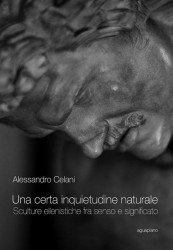 Umbra Professor Alessandro Celani has published a new book, A Certain Natural Pain: Hellenistic Sculptures Between Sense and Meaning, (Naturalis Quidam Dolor: Sculture ellenistiche fra senso e significato) focused on the birth and development of various artistic trends in the art of central Italy during the Hellenistic Age (3rd to 1st centuries B.C.E.), including: baroque, classicist, mannerist, etc. Various individual statues, portraits, and sculptural groups from Latium and Rome are described, interpreted, and put in relation with their socio-cultural background. The method, closer to the sociology of art than to pure archaeology, tends to bound the scholarly categories to each other rather than sharpening individual viewpoints and conclusions.
Umbra Professor Alessandro Celani has published a new book, A Certain Natural Pain: Hellenistic Sculptures Between Sense and Meaning, (Naturalis Quidam Dolor: Sculture ellenistiche fra senso e significato) focused on the birth and development of various artistic trends in the art of central Italy during the Hellenistic Age (3rd to 1st centuries B.C.E.), including: baroque, classicist, mannerist, etc. Various individual statues, portraits, and sculptural groups from Latium and Rome are described, interpreted, and put in relation with their socio-cultural background. The method, closer to the sociology of art than to pure archaeology, tends to bound the scholarly categories to each other rather than sharpening individual viewpoints and conclusions.
Styles and manners are put in relation to: behaviour (speech, gestures, theatre and oratory, sport), to the consumption of luxury goods (textiles, furniture, decorative arts, jewels, etc.), and to epigraphy and various forms of oral literature (funerary speeches, symposium songs, comedies).
The first part of the book is methodological, with in-depth incursions into the theory of art (ancient and modern). The second part is based on three major topics: the male nude (honorary statues from Formia, Minturno, Rome), portraits (from Terracina and Rome), and the drapery on female statues (from Palestrina, Rome, the Greek islands and Asia Minor). A short appendix covers mythological statues and groups (from Sperlonga and Rome).
The last chapter is a long visionary reflection on the relations between statues, architecture and human beings, from Cicero and Lucretius to Hanna Arendt.
The iconographical documentation is almost entirely new (black and white photographs by the author).
Professor Celani is currently teaching HSRS 345: Pagans and Christians: Ancient Mediterranean Religions.
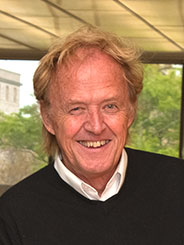
The Umbra Institute is excited to announce the release of two new books by visiting Professor Alex R. Hybel, Professor of Government and International Relations at Connecticut College.
In collaboration with selected Connecticut College students enrolled in his US Foreign Policy Decision-Making class, Hybel set out to apply multiple foreign policy decision-making theories to a series of presidential case studies. The result is an exploration of experiential and intellectual factors, and two volumes, US Foreign Policy Decision-Making from Truman to Kennedy and US Foreign Policy Decision-Making from Kennedy to Obama, published by Palgrave Macmillian.
Hybel starts both works with an introduction to the complexity and interwoven nature of foreign policy decision-making. “Foreign policy decision-making analysts have long argued that the interests of the United States, whether strategic, political, or economic, do not automatically impose themselves as objective data upon foreign policy decision-makers who […] use their rational faculties to design foreign policy” (2014, p.1). Decision-makers disagree on how problems should be defined, how gathered information should be interpreted, and what alternatives should be evaluated, and, ultimately, selected for implementation.
This discussion sets the stage for the multiple objectives that Hybel, along with his Connecticut College collaborators attempt to fulfill: describe foreign policy-decision making processes generated and utilized by various presidents; gauge the explanatory value and theoretical applicability of leading foreign policy decision-making models; incorporate discussed models in relation to the president’s cognitive system and dominate mindsets of the times; and assess the quality of the designed foreign policy decision-making processes. Ultimately, with these works, Hybel aims to “introduce […] readers to core foreign policies that have placed the United States at the forefront of world affairs” (p.2).
The Umbra Institute will be hosting a presentation by Professor Hybel on these manuscripts on Monday, March 24th at 7pm in the Umbra Library (Piazza IV Novembre, 23). An open discussion with the author will follow the presentation.
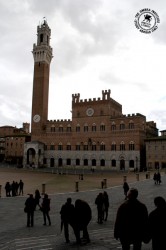
While studying abroad, Umbra students have a multitude of opportunities to learn first-hand about the customs and traditions of Italy. To add historical context to some of these experiences, students enrolled in Umbra course SOIT 360: Contemporary Italy, Culture, Society, and Trends gain deeper insight into Italian culture by exploring events, trends and social phenomena.
Siena’s Palio is one such tradition studied in class. Il Palio, medieval in origins, is a bareback horse race that takes place twice yearly in Siena’s central piazza, Piazza del Campo. Participating riders represent 10 of Siena’s 17 contrade, or neighborhoods, each jockey wearing the colors of their contrada. While this event occurs only on July 2nd and August 16th, preparations last all year, and include discussion of strategies, commitments by jockeys, and the commissioning of the silk banner that will go to the winning contrada. It must follow specific iconography: a Madonna, the insignia of the city, and the colors or symbols of the participating contrade. During the week leading up to the event a lottery is held to determine the horse that will run for each contrada, preparations are made in the Piazza del Campo – including an addition of a layer of dirt to form the race track – and blessing of the horses and jockeys are held. After months of preparations and pageantry, the Palio begins- three laps around the piazza, typically lasting under 90 seconds.
While Contemporary Italy students won’t have an opportunity to witness the Palio during their semester with Umbra, they did have the chance to visit Siena earlier this month and see where it all takes place, including a rare, private tour of one of Siena’s historic contrade, L’Aquila, or the Eagle. Established in the Middle Ages to supply military troops to the city, the contrade have become the embodiments of local patriotism and civic pride. Each contains their own baptismal font, museum, and fountain, and additionally has allies and adversaries amongst the other contrade.
Visiting the Aquila museum, students were surrounded by yellow, trimmed with blue and black (the contrada colors) and representations of a double-headed black eagle holding a sword, orb and scepter. These displays of local pride included the silk banners that the Aquila contrada won through their 24 official victories, the oldest of which dates to 1719 and is also the oldest surviving banner of Siena. After walking its cobbled streets and speaking to local Sienese, Umbra’s students left with a deeper understanding and appreciation of the impact that the contrade and Palio have on the daily lives and traditions of Siena.
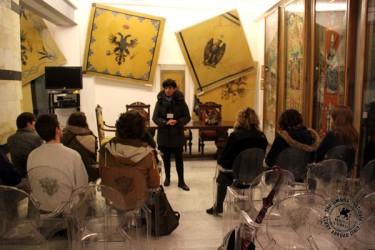
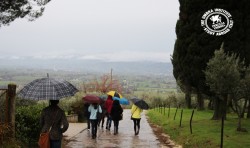
On an early Friday morning, 12 students braved the light rain and wind to walk in the footsteps of Saint Francis and Saint Clare of Assisi. Led by Prof. Adrian Hoch, the students in HSWS 380: Saints, Sinners, and Harlots journeyed to Assisi to experience first-hand the art and history surrounding these important figures.
The trip started with a visit to the Porziuncola (a church within a church) at Santa Maria degli Angeli, where the Franciscan movement began when Saint Francis received his vocation. This was followed by a visit to the churches of San Damiano and Santa Chiara, which were important historical sites in the life of Saint Clare.
At San Rufino, a kindly nun invited the students and Prof. Hoch to view the oratory where St. Francis and his followers had prayed in the early days of the order. This was quite a unique experience as it was the first time that Prof. Hoch, in her many years as an instructor, had ever seen the oratory.
After an extended and well-deserved lunch, the students and Prof. Hoch were back in action at the last stop on the trip: the famous Basilica of Saint Francis of Assisi. Led through the fresco-covered lower basilica, down to the solemn crypt of Saint Francis, and concluding in the expansive upper basilica, the students saw the past come to life in one afternoon.
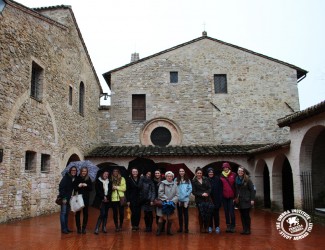
The sun was shining this past Saturday on the picturesque village of Panzano-in-Chianti, as the Umbra Institute’s STFS 330: Sustainability and Food Production in Italy class, accompanied by Professor Elisa Ascione, enjoyed a stroll through the countryside and an astonishing twelve-course meal at Macelleria Cecchini, Dario Cecchini’s world-renowned butcher shop!
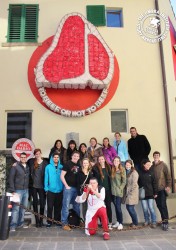
The day began with a hike through Chianti’s storied vineyards, throughout which Professor Ascione described the fascinating history of the region and its people.
After working up quite the appetite, the class entered Macelleria Cecchini to the sounds of Black Sabbath and the smell of freshly-baked bread. There they were met by the inimitable Dario Cecchini himself. A fourth-generation butcher, Dario’s family has had its shop in the same building for over 200 years.
Recently, Dario has taken it upon himself to bring more sustainable practices to his business, such as raising his cows in their natural habitat in Spain and serving his customers all cuts of meat – not just the “choice” ones.
The Sustainability class experienced this “waste nothing” philosophy in action as they dug into a meal Cecchini calls “La Vacca Interna” – “The Whole Cow,” a carnivorous extravaganza featuring 12 cuts of beef prepared in different ways, and finished with cake, coffee, and a question from Dario: “To beef or not to beef?”
Umbra’s BSFS 380: The Business of Wine: Italy and Beyond explores the business and marketing of wine, with particular focus on U.S. markets, combined with a service learning component that allows for real world experience through a partnership with a local Umbrian company.
This semester, Umbra will be continuing its partnership with Goretti Winery, a 3rd and 4th generation, family-run winery located in nearby Pila. From the cultivation of the grapes to production of their wines, the Goretti family is committed to creating the highest quality products for their customers. Their goal is to continue building their business in various markets abroad, especially within the United States.
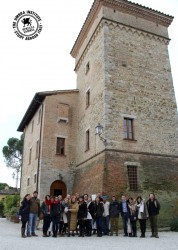
To assist Goretti in obtaining this goal, Umbra students will be completing a marketing analysis of Goretti competitors, potential pricing competition, selling points and communication strategies. Informed by classroom lectures, readings and a company visit, participants will develop marketing plans for Goretti’s Sagrantino di Montefalco wine; and will present their findings and recommendations to Goretti representatives at the end of the semester.
“Over the course of this semester, my goal with this service learning experience is to gain a more well-rounded understanding of a business,” commented Virginia Commonwealth University alumni, Ashley Patino. “Umbra’s partnership with Goretti will provide the perfect opportunity to gain that experience hands-on.”
“During our recent field trip to Goretti, we had the chance to see firsthand the work, tradition and care put into every single bottle,” added Connecticut College student Heather Rochford. “After that experience, I see more than just a bottle of wine, and that will impact my service learning projects link to the winery.”
The Umbra Institute is committed to creating innovative international education opportunities for students, allowing for immersion into the local community. Service learning at Umbra links critical thinking and academic coursework with personal reflection and collaboration with the local community. Participation allows students to become active participants in their learning, both in and outside of the classroom.
The Umbra Institute is proud to introduce the first edition of the Trasimeno Archaeology Field School, a curricular concentration which provides students with a comprehensive overview of up-to-date theories and methods of archaeological research and fieldwork, as applied to the civilizations that shaped the history and culture of central Italy.
The Trasimeno Archaeological Field School is based in the medieval town of Castiglione del Lago, on the southwestern shores of Lake Trasimeno, only a few miles from Perugia and on the border between Umbria and Tuscany. Recent surveys of the land have indicated the presence of a rich archaeological site encompassing a Roman building as well as Etruscan tombs.
The Field School consists of two courses held during the Umbra Institute’s General Studies Summer Session: an archeology practicum (ARFW 350: Archaeological Field Workshop) and an optional theoretical course on archeological campaigns in central Italy (ARCL 340: Archaeology in Central Italy: The Etruscan and Roman Legacy). The inaugural group of students will be trained by professional archaeological staff and attend lectures on the methods of excavating, recording, and interpreting. Field trips to other historic sites and museums will contribute to the overall learning experience.
Archaeology Field Workshop Professor Giampiero Bevagna explains the unique opportunity central Italy offers archaeology students: “We are exploring in chronological sequence almost 2000 years of cultural development. The excavation in Castiglione allows us to analyze layer by layer the most important civilizations that shaped the history of central Italy: from the mysterious Etruscans to the Romans, up to the medieval era. Digging in Castiglione will be just like reading a forgotten book of history.”
For more information visit the Archaeology Field School page
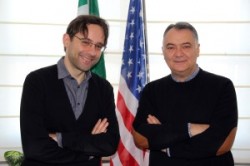 Umbra academic director dott. Burzacca and Accademia director dott. Belardi.
Umbra academic director dott. Burzacca and Accademia director dott. Belardi.
The Umbra Institute has signed an exchange agreement with Perugia’s school of fine arts, the Accademia di Belle Arti “Pietro Vannucci”. As a result, Umbra students will be able to enroll in courses covering an incredible variety of artistic disciplines, such as painting, drawing, industrial design, and even marble sculpture and metal working.
Accademia students will enjoy access to world-renown faculty as well as a majority Italian student body, allowing for the improvement of language skills in a practical setting. As part of the agreement, Italian students from the Accademia will also have the possibility of enrolling in Umbra courses to internationalize their curricula.
The Accademia is centrally-located just down the street from
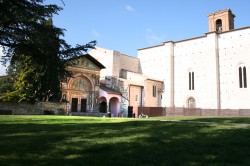
Umbra’s own photography, painting, and fresco facilities
in one of Perugia’s most famous buildings, San Francesco al Prato. The school was founded in 1573 as the Accademia del Disegno and is the second-oldest school of fine arts in Italy.


